|
Two Technologies N4
Like having leading-edge Android consumer technology in a very tough case, and then some
by Conrad H. Blickenstorfer, with photography by Carol Cotton
A little while ago, I made an appointment to have the fireplaces in my house inspected and cleaned. Any notion I had of an old-fashioned, soot-covered chimney sweep like you see in movies where quickly dispelled when the clean-cut serviceman pulled out a high-powered magnesium flashlight and a small tablet computer as he went about his job. He used the tablet to jot down observations and taking high-res pictures of the inside of the chimney. When he was done I asked him how he liked his tablet, which turned out to be a Samsung Galaxy Note II. He said he loved it, but wished it were tougher. Just the other day, he said, one broke when a colleague dropped his on the job. I showed him the N4 from Two Technologies which so happens to be a Samsung Note II in a sophisticated suit of armor. The man was nearly speechless as he perused the N4. "Yes," he said, "I could sure use one of those."
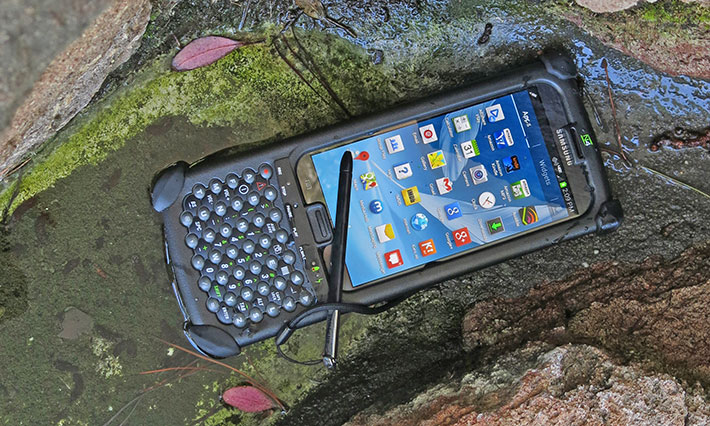
And that, my friends, is the big issue. A lot of folks out there could sure use a tablet that can do all the cool stuff consumer smartphones can do, but one that won't break out there on the job where things can get wet and rough. There are, of course, such handhelds and tablets, and we cover all of them in detail here at RuggedPCReview.com. The problem is that state-of-the-art consumer technology and industrial-grade ruggedness are mutually exclusive for a variety of reasons.
What is the Two Technologies N4 platform?
Apart from any consumer technology vs. professional grade gear philosophical issues, here's what you get with the N4—a rugged handheld that's totally waterproof, has a super-high resolution 1280 x 720 pixel AMOLED capacitive multi-touch screen and an inductive stylus, a 70-key backlight alphanumeric keypad, 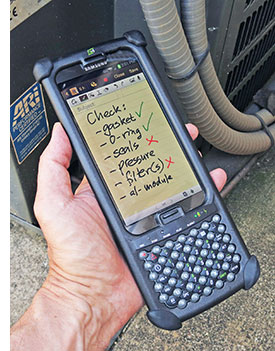 Android version 4.3 ("Jelly Bean"), dual cameras (including an 8 megapixel one that can also do 1080p HD video), all powered by a 1.6GHz quad-core Samsung ARM Cortex-A9 processor, and with enough battery power to last through three full shifts. That is quite impressive, to say the least. Especially since we haven't even mentioned all of the N4's specs that also include 4G LTE, NFC, hot-swappable batteries, optional mag stripe reader and, of course, the whole thing is built tough enough to pass any number of MIL-STD 810G military testing procedures. Android version 4.3 ("Jelly Bean"), dual cameras (including an 8 megapixel one that can also do 1080p HD video), all powered by a 1.6GHz quad-core Samsung ARM Cortex-A9 processor, and with enough battery power to last through three full shifts. That is quite impressive, to say the least. Especially since we haven't even mentioned all of the N4's specs that also include 4G LTE, NFC, hot-swappable batteries, optional mag stripe reader and, of course, the whole thing is built tough enough to pass any number of MIL-STD 810G military testing procedures.
The display specs are unprecedented in a rugged handheld. The 5.5-inch diagonal screen size is larger even than that of Samsung's pocket-busting Galaxy S4 consumer smartphone. It's also, to the best of our knowledge, the first rugged industrial handheld using an AMOLED display. 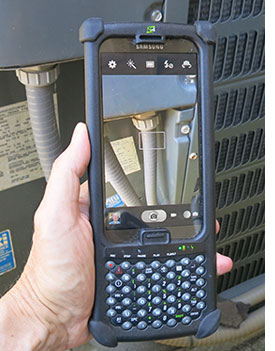 AMOLED stands for Active Matrix Organic Light Emitting Diode, and the way it works is that each individual pixel generates its own light, unlike conventional displays that require a backlight. That means better and more vibrant colors, a thinner display assembly, and lower battery consumption. AMOLED has become popular in consumer smartphones, but is it up to rugged use? Well, Atomics Aquatics uses OLED displays in its Cobalt scuba diving computers that must be invulnerable to pressure and temperature, as well as hyper-efficient and utterly reliable (I've personally seen it used at 90 feet on a murky, cold Pacific wreck dive). As for the 1280 x 720 pixel resolution, that means about 265 pixels per inch, or the same pixel density as the 4th generation iPad. AMOLED stands for Active Matrix Organic Light Emitting Diode, and the way it works is that each individual pixel generates its own light, unlike conventional displays that require a backlight. That means better and more vibrant colors, a thinner display assembly, and lower battery consumption. AMOLED has become popular in consumer smartphones, but is it up to rugged use? Well, Atomics Aquatics uses OLED displays in its Cobalt scuba diving computers that must be invulnerable to pressure and temperature, as well as hyper-efficient and utterly reliable (I've personally seen it used at 90 feet on a murky, cold Pacific wreck dive). As for the 1280 x 720 pixel resolution, that means about 265 pixels per inch, or the same pixel density as the 4th generation iPad.
For operation of this marvel of a display, there's capacitive multi-touch, which the billion or so folks who use smartphones on the planet now expect, and which also works by far the best with touch-oriented OS platforms such as Android and the iOS. For rugged devices, there are some potential drawbacks to capacitive touch—the technology is not glove-friendly and it doesn't work when wet. The latest versions of capacitive touch can actually be used with some thin gloves, but that's not much of a problem for the N4, thanks to a special screen cover. The N4 also comes with a small inductive stylus that doesn't need a battery. It uses Wacom technology, which is very mature, wide-spread, and very well supported. Take any Wacom pen and it works on the N4.
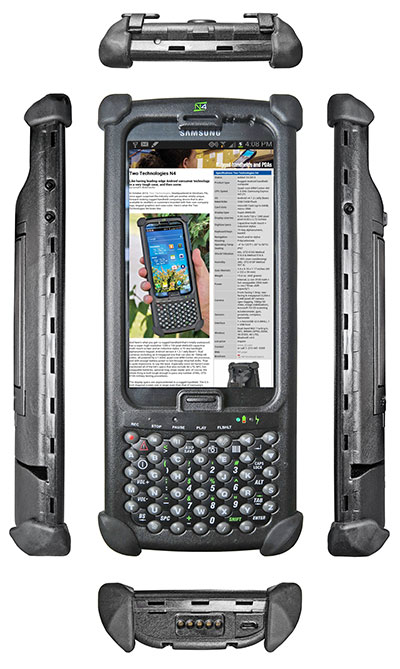 However, just in case that capacitive multi-touch and an active pen still aren't enough for an application, the N4 also has that integrated 70-key backlit keyboard that has dedicated keys for just about everything. Yes, it looks a little cramped and busy, but consider that the N4 is almost four inches wide; anyone who has ever used a Blackberry or a thumbtype phone will feel right at home with it. However, just in case that capacitive multi-touch and an active pen still aren't enough for an application, the N4 also has that integrated 70-key backlit keyboard that has dedicated keys for just about everything. Yes, it looks a little cramped and busy, but consider that the N4 is almost four inches wide; anyone who has ever used a Blackberry or a thumbtype phone will feel right at home with it.
What does the N4 have under the hood? Here again, 2T's latest transcends conventional rugged handhelds with a 1.6GHz quad-core ARM Cortex-A9 processor that appears to be a Samsung Exynos 4412. There's 2GB of RAM, 16GB of Flash storage, and an internal microSD card slot for up to 64GB of additional storage, with 16GB installed. There is also a full complement of integrated sensors (accelerometer, gyro, proximity, compass, barometer) that one would expect to find in a consumer smartphone or tablet, but not in a rugged device. And the cameras are up to snuff as well. 1.9 megapixel facing the user, and 8.0 megapixel on the back. The latter camera, with auto-focus and LED illuminator, can record pictures and video simultaneously, it can do geo-tagging, face detection, and recording is image-stabilized. And the video is full 1080p at 30 frames per second, i.e. HDTV. That camera is also used for scanning as 2T mentions Accusoft 1D/2D scanning software.
What about connectivity? On the wired side there's a micro USB port and connectivity via dock. For wireless, the N4 offers dual-band 802.11a/b/g/n WiFi, hotspot and DNLA capability, as well as A-GPS and 3G and 4G wireless data. And for near field communication, there's HD RFID as well. The N4 also has a 3-channel mag stripe reader that is not a snap-on affair, but an integral part of its encosure.
How is all of this technology powered? With two batteries. One is an integrated 3,100mAH L-Ion, the other an externally accessible 2,500mAH Li-Ion. They work together, making for hot-swappable battery power in the N4, and, according to Two Technologies, three shift operation, which we interpret as 24+ hours.
How rugged is the N4? Much more than you'd expect. The specs aren't complete, but the device has a very wide -4 to 122F operating temperature range, 2T refers to MIL-STD 810G 514.6 and 516.6, which cover vibration and shock, and the N4 is IP67-sealed. The latter means it's totally dustproof, and also waterproof, including immersion. 2T is good at waterproofing their gear (we've had some of their rugged handhelds on scuba underwater). The N4 has black rubber bumpers on its corner, which isn't terribly elegant but quite effective in warding off damage.
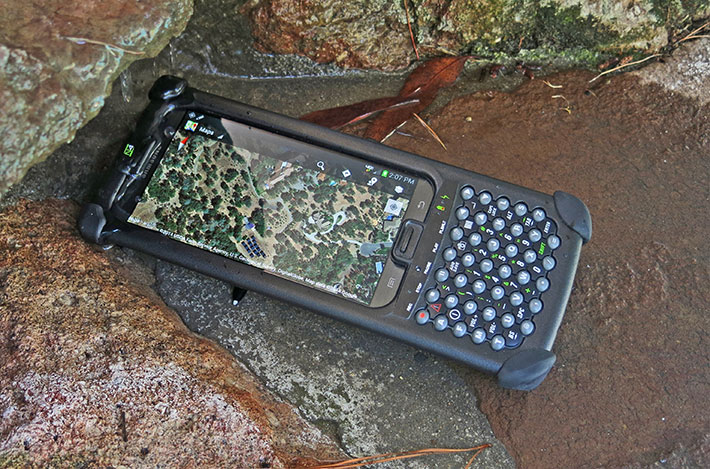
What do we make of all this? From a technology standpoint, the N4 is right up there with the latest consumer smartphones and phablets. In an era where an alarming (for the rugged computing industry) number of large customers opt for consumer technology in a protective case instead of traditional rugged devices, this approach makes a lot of sense, sort of the best of two worlds. This is definitely a device that had to happen.
What does it all mean? — Q&A with 2T's CEO
RuggedPCReview.com — As expected, the N4 is a most impressive machine. And as we had initially deduced from the specs, it seems it's a Galaxy Note II in a "mech warrior" suit. 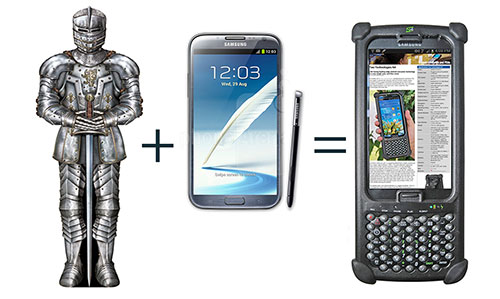 Given the massive success of consumer smartphones and tablets, and the growing number of enterprises that simply buy consumer technology and put it in a protective case, it is not at all unreasonable for a rugged company to go that path, making sure it's done right, and perhaps with (considerable) value added. Given the massive success of consumer smartphones and tablets, and the growing number of enterprises that simply buy consumer technology and put it in a protective case, it is not at all unreasonable for a rugged company to go that path, making sure it's done right, and perhaps with (considerable) value added.
So this brings up two issues.
The first is that it's quite obvious that it's a Samsung Note II to anyone who has hands-on, and since the Samsung logo isn't covered I suppose you're not actively trying to hide its origin. So are we going to pretend it's not a Samsung or simply gloss over that fact?
OR do we treat this as a virtue which would, second, include a description and analysis of all the value-added that 2T is bringing to the table? The latter would also mean including some of 2T's thought and decision process, how you went about it, what the goals were, and how you see the overall philosophy of going this route rather than constructing a rugged device from scratch.
David Young, 2T President and CEO — We specify in our brochure that the platform in the N4 is a Samsung Galaxy Note 2. Clearly, we are not trying to hide the source of the computing platform.
This is a new business model for us. Spending several hundred thousand dollars per year to support a proprietary platform makes no sense to us. You are among the best people in the world to compare specifications of the N4 with all others. Compare the N4 specifications with TDS or Honeywell and Motorola. In every case we blow them away. Why on earth we want to offer our own platform on the bleeding edge of technology when Samsung will do it for us?
No doubt there will be a subset of potential customers that refuse to accept a device powered by a consumer driven platform. Hiding or otherwise covering the Samsung logo will cut both ways. I have never been able to satisfy all potential customers but the N4 is closer than I have come in the 27 years of our history.
We truly add significant value and sell it for a fair price. Our first customer is a company engaged in issuing parking and traffic citations and the N4 has been an unqualified success. Police officers are not inclined to judge a product on any basis other than pure productivity.
The single question that I would ask as an end user: Which product on the market provides the best value to my application? Value is a complicated formula. From our perspective, nothing in the market comes close.
A hot swappable battery to avoid interrupting an application for as long as you like is a significant feature for some applications. It is apparently more important than we could have imagined.
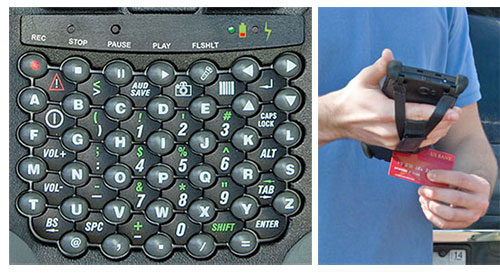 As we have done since 1987, the keypad can range from no keypad at all up to 70 keys. Keypad nomenclature can be designed to perfectly suite virtually any application. Our business model has always included customization to suit any particular need. As we have done since 1987, the keypad can range from no keypad at all up to 70 keys. Keypad nomenclature can be designed to perfectly suite virtually any application. Our business model has always included customization to suit any particular need.
The Magnetic Stripe Reader was first intended to input a driver license but is being used in many other types of applications requiring a secure MSR.
I gladly invite our competition to maintain a cutting edge platform that is most often inferior to our N4. The Note 2 is simply a good platform to build an applications appliance. We have searched the world for a cutting edge display for a new platform. Not surprisingly, we wanted a display that matched the performance and physical qualities of the Samsung Note 2. We found it; and it comes with a dynamite computing platform.
Controlling Android apps with SureLock
The initial N4 that Two Technologies sent us was built on a carrier-specific version of the Galaxy Note II (in our case Verizon). It came with Android 4.1.2 and all of the apps included by the carrier. That meant 54 apps, offering all the wealth of information and entertainment smartphone and tablet users are accustomed to.
Having all of that available on a vertical market device PLUS ready access to the Google Play Store with its thousands of downloadable apps seemed almost too much of a temptation on a professional tool for jobs out there in the field, but we figured there probably was a way to yank all those tempting apps from the device. And there was.
While we were still evaluating the N4, Two Technologies informed us of a new version that comes with Android 4.3. As far as Google's OS code naming goes, versions 4.1, 4.2 and 4.3 are all part of "Jelly Bean," and the changes are fairly minor (see Wikipedia on new Android version 4.3 features). Two Technologies sent us one of the updated units, and we immediately noticed a big difference: only seven apps: Barcode reading, camera, web browser, maps, notes, voice recorder, and settings. Where did the rest go?
It's still all there, but the new version came with a licensed copy of 42Gears.com's SureLock. SureLock replaces the Android desktop and allows control of applications that are available to users. SureLock can even be configured to run in "kiosk mode" with just a single application that is always active. This way, systems integrators or IT personnel can configure N4 units for specific use and applications, eliminating the temptation that comes with a full load of consumer apps. Makes perfect sense.
Ruggedness
Anyone who's ever used a Samsung Note II knows that while it's a high-quality device, it's definitely not a rugged one. So can the fortified Two Technologies N4 truly be a rugged device? Yes, it can. That's because the N4's protective armor is considerably more integrated with its Samsung interior than any mere case can ever be. Which means:
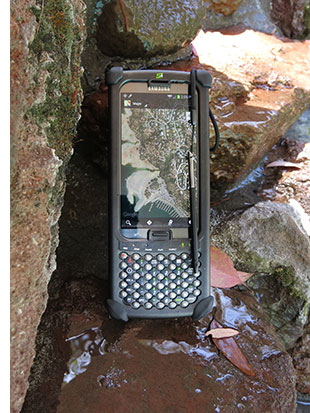 - For ingress protection, the Two Technologies N4 rates a stellar IP67. The first number stands for protection against solids. 6 is as high as it gets, and it means the unit is totally protected against the finest dust. The second number is for the degree of protection from liquids. That scale goes from 0 (no protection) to 8 (totally immune to water, even indefinite immersion). A 7 means the device is protected against the effects of immersion into water, up to a certain extent. IP67-rated devices are usually sealed to survive half an hour or so under a meter, 3.3 feet, of water. Admittedly, it takes a leap of faith to dunk a Samsung phablet into the water, no matter how well protected. But we did it, and it easily survived the test.
- The N4 has a wide operating temperature range of -4 to 140 degrees Fahrenheit (-20 to 50 Celsius). That makes the N4 suitable for deployment in just about any environmental setting, even freezers.
- As far as the ever-popular drop testing goes, the N4 survives multiple drops from four feet onto concrete. That's generally considered the height a device might fall when operated in a standing position. Given the N4's Two Technologies origin, we suspect it can probably handle more than four feet. In their promos, there's a video of a car driving over an N4, without any harm done to the unit.
We should also mention the rain shield that comes with the N4. It's a clear polycarbonate piece with an adhesive gasket around its perimeter. Its purpose is to allow the N4 to operate in rain, snow or sleet, something capacitive touch panels alone cannot do as they can't distinguish between a rain drop or a finger touch. With the shield in place, the N4 can be operated with both a stylus or bare finger, albeit requiring a considerably firmer touch.
But what about the large 5.5-inch display itself? Consumer phone and tablet screens crack all the time, and the N4's display surface is stock Samsung. Yes, but unlike a totally flat surface of a standard Samsung Note II, in the N4 the display is recessed by 1/8th of an inch, and there's the additional protection of the rubber corner bumpers. This means the N4 can drop smack onto its face without breaking. If, of course, it were to take a direct hit onto its display, that'd be another story.
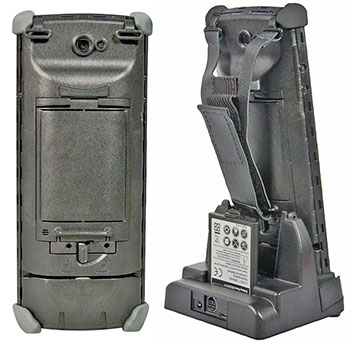 The sole weakness we detected in our two N4s were a) the plastic clasps of the handstrap (one broke), and b) the somewhat fragile stock Samsung inductive pen, especially since the rugged enclosure has no garage to safely stow it away. The sole weakness we detected in our two N4s were a) the plastic clasps of the handstrap (one broke), and b) the somewhat fragile stock Samsung inductive pen, especially since the rugged enclosure has no garage to safely stow it away.
Power
The N4's underlying Samsung Note II platform has an internal battery that, according to 3rd party tests, is already good for about nine hours of web browsing, over 11 hours of video playback, and almost 17 hours of 3G talk time.
That battery, however, is not user accessible, and so Two Technologies added a second one that neatly fits into the back of the device. This gives the N4 hot-swappable battery capability, and thus essentially unlimited run-time. The external battery is a Samsung EB615268VA and thus widely and inexpensively available.
The N4's dock has an extra charging slot in the back, allowing users to charge both the N4 and a backup battery at the same time. Charging a depleted unit and depleted battery simultaneously takes about three hours. There are charging contacts on both sides, so users must make sure to insert the battery to be charged the right way, else it won't charge.
The dock itself also has what looks like a PS/2-style keyboard/mouse port but is actually a diagnostics port, and a micro-USB port.
Two Technologies N4: Bottom line
With the N4, Two Technologies presents a bold answer to the question of how the experienced rugged device manufacturing industry can take advantage of the massive worldwide acceptance of smartphones and tablets — take a state-of-the-art consumer product such as the Samsung Galaxy Note II and integrate it into a housing that's not just any third party case, but a sophisticated enclosure that complements and enhances the donor tablet platform while also providing the extraordinary degree of ruggedness and customization the company has offered for decades.
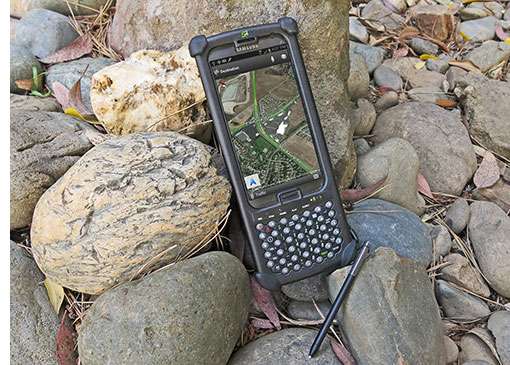 This approach offers a level of technology generally unavailable in vertical and industrial market devices. There's the powerful 1.6GHz quad-core ARM processor, the gorgeous 1280 x 720 pixel 5.55-inch AMOLED multi-touch screen, the Wacom pen with software for wonderfully smooth drawing and precise calligraphy, superior cameras that can easily record 1080p HD video, and all the other goodies and features millions now expect from any handheld device. This approach offers a level of technology generally unavailable in vertical and industrial market devices. There's the powerful 1.6GHz quad-core ARM processor, the gorgeous 1280 x 720 pixel 5.55-inch AMOLED multi-touch screen, the Wacom pen with software for wonderfully smooth drawing and precise calligraphy, superior cameras that can easily record 1080p HD video, and all the other goodies and features millions now expect from any handheld device.
On the other hand, this modified COTS (Commercial Off The Shelf) presents some compromises. The small pen is fragile. The rugged enclosure means no access to the donor device's pen garage, internal battery or microSD card slot. And with the very short life cycle of consumer market devices, what happens if the donor Samsung tablet is no longer available? Or if this approach becomes common practice, what happens if the donor device manufacturer simply decided they may as well offer such rugged versions of their products themselves?
These philosophical issues aside, Two Technologies's N4 is an absolutely remarkable device that truly offers the best of both worlds — the state-of-the-art consumer technology that everyone has come to expect from handhelds AND the extreme ruggedness that's required out there on the job and in the field. -- Conrad H. Blickenstorfer, June 2014
|
Two Technologies N4 Specs:
|
|
Added/changed
|
Added 10/2013, full review 05/2014
|
|
Form-factor
|
Rugged Android handheld computer
|
CPU/Speed
|
1.6GHz quad-core Samsung Exynos (4412?)
|
Graphics
|
Mali-400MP GPU
|
OS
|
Android v4.3
|
RAM/ROM
|
2GB/16GB Flash
|
Card slots
|
microSD Card (up to 64GB), micro-SIM
|
Display type
|
Super AMOLED
|
Display size/res
|
5.55-inch/720 x 1280 pixel pixel (4.83 x 2.72 inches)
|
Digitizer/pens
|
Capacitive multi-touch + inductive stylus
|
Keyboard/keys
|
Backlit 70-key QWERTY or alpha-numeric with inversion lockout; glove-friendly and fully customizable
|
Navigation
|
Touch and/or inductive stylus
|
Housing
|
Glass-filled polycarbonate resin
|
Operating Temp
|
-4° to 122°F (-20° to 50°C)
|
Sealing
|
IP67 (waterproof and dustproof)
|
Shock/Vibration
|
MIL-STD 810G Method 516.6 & Method 514.6
|
Humidity
|
5-95% (non-condensing) (MIL-STD 810F Method 507.4)
|
Vibration
|
MIL-STD-810G Method 514.6
|
Altitude
|
Unknown
|
Certifications
|
Unknown
|
Intrinsic safety
|
Unknown
|
Size (WxHxD)
|
3.9 x 9.15 x 1.17 inches (99 x 232 x 39 mm)
|
Weight
|
15.6 oz. (442 grams)
|
Power
|
Internal Li-ion 3,100 mAh + external hot-swappable 3.7V, 2,500 mAh Li-ion, 9.25 watt-hour ("three-shift capacity")
|
Sensors
|
Accelerometer, gyro, proximity, compass, barometer
|
Interface
|
1 x microUSB v2.0 (MHL), 1 x USB host
|
GPS
|
A-GPS support + GLONASS
|
Mag Stripe
|
3-channel bi-directional card reader with DES/triple DES/AES encryption
|
Camera
|
Front-facing 1.9mp; rear-facing 8-megapixel (3,264 x 2,448 pixel) AF camera (geo-tagging, 1080p/30 video, image stabilization), Accusoft 1D/2D scanning
|
Wireless
|
Dual-band 802.11a/b/g/n, NFC, WWAN (GPRS, EDGE, 3G EVDO 850/1900/2100, 4G LTE 700), Bluetooth v4.0 with A2DP, LE, EDR
|
List price
|
Inquire
|
Web page
|
N4 page on 2T website
|
Brochure
|
2T N4 specs (PDF)
|
Contact
|
Two Technologies, Inc., 419 Sargon Way, Horsham, PA 19044, Tel: 1.215.441.5305
|
Warranty
|
1 year
|
|
|



